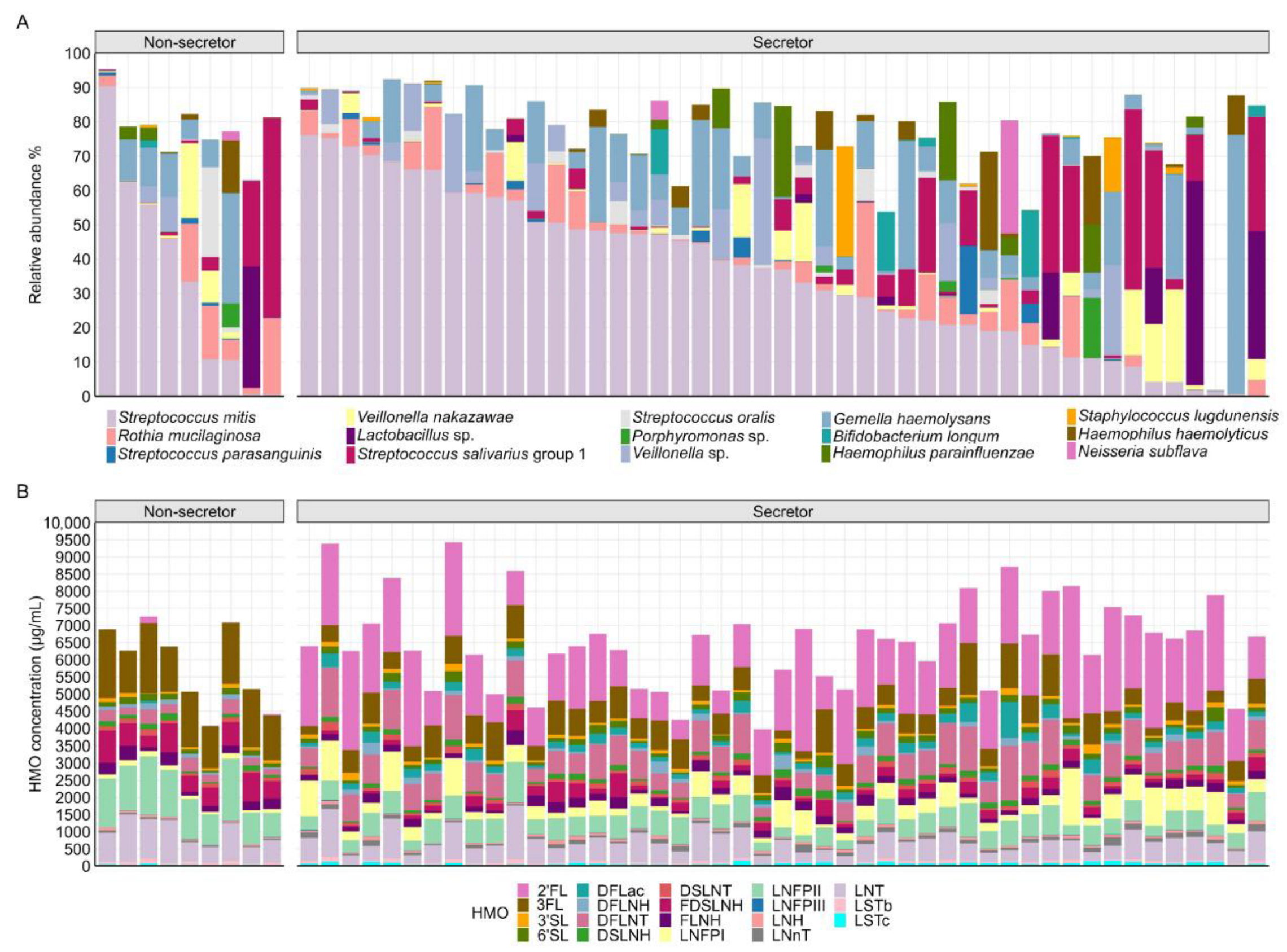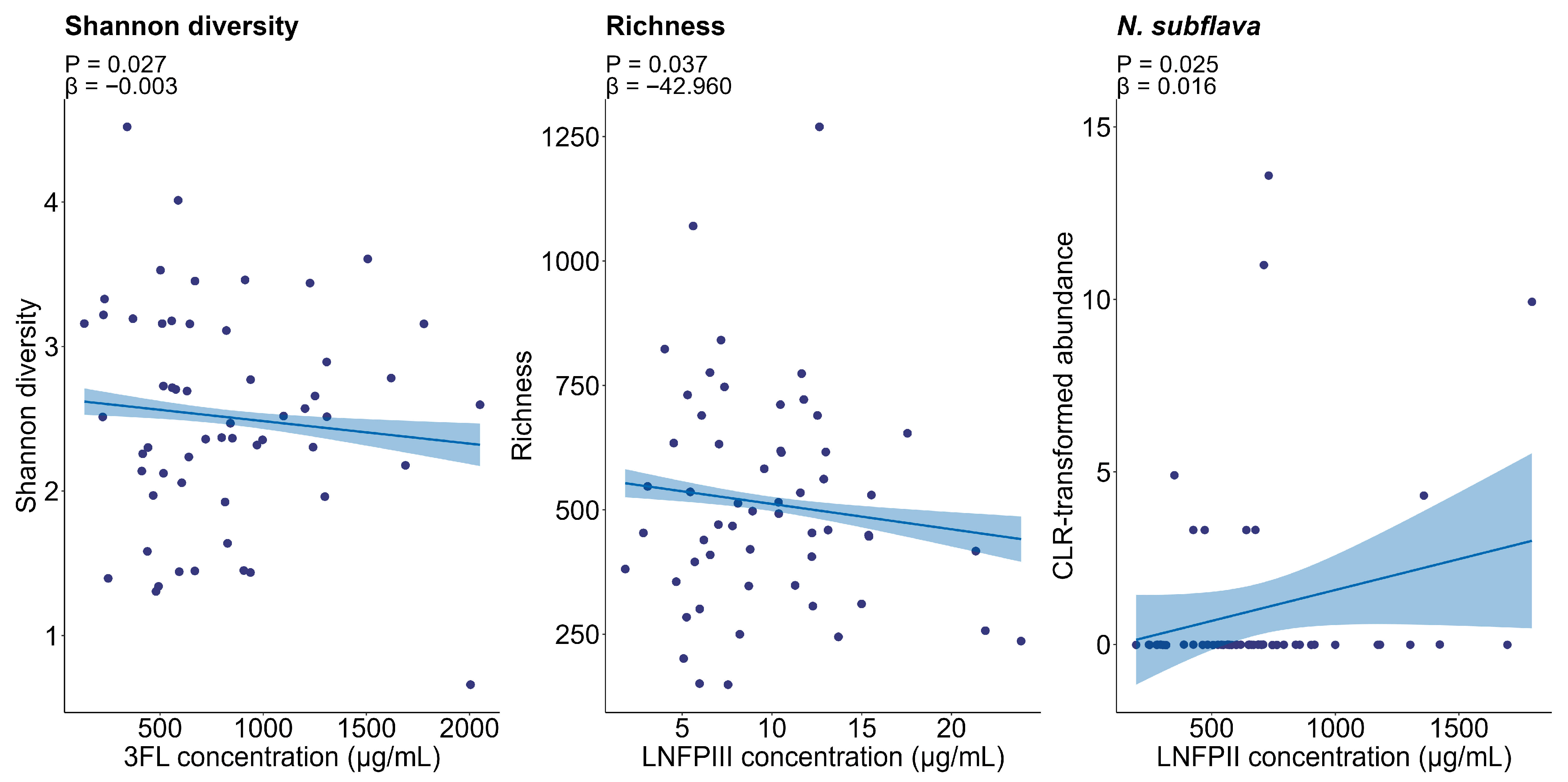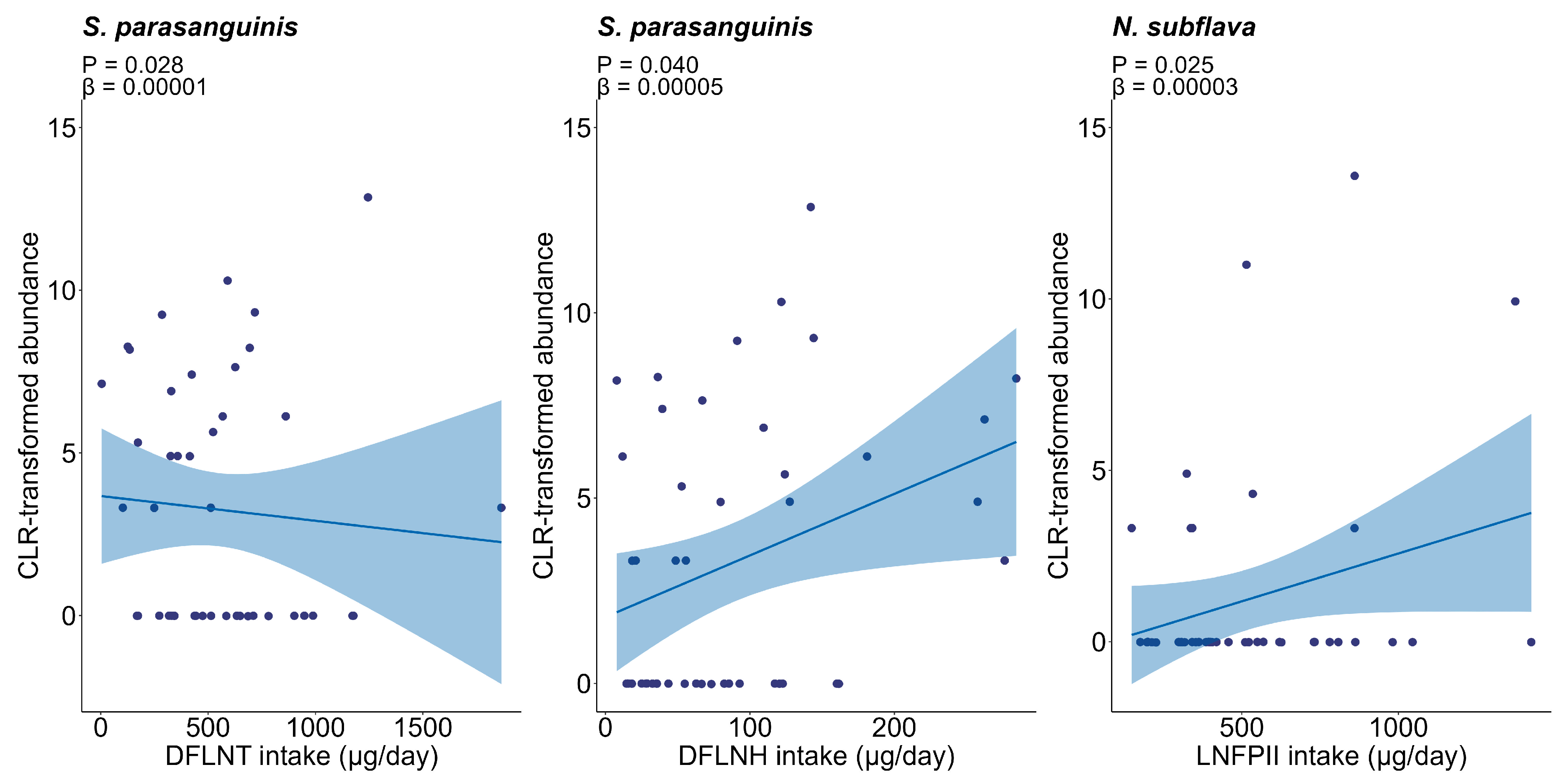Development of the Breastfed Infant Oral Microbiome Is Associated with Concentrations and Intakes of Human Milk Oligosaccharides
Abstract
1. Introduction
2. Materials and Methods
2.1. Study Design
2.2. Sample and Data Collection
2.3. Human Milk Oligosaccharides
2.4. 24 h Milk Intake
2.5. Daily Intake of Human Milk Oligosaccharides
2.6. Infant Oral Microbiome Analysis
2.7. Sequencing Data Processing
2.8. Data Analysis
3. Results
3.1. Infant Oral Microbiome Composition
3.2. Human Milk Oligosaccharides
3.3. Influence of Human Milk Oligosaccharides on the Infant Oral Microbiome
4. Discussion
5. Conclusions
Supplementary Materials
Author Contributions
Funding
Institutional Review Board Statement
Informed Consent Statement
Data Availability Statement
Acknowledgments
Conflicts of Interest
References
- Holgerson, P.L.; Vestman, N.R.; Claesson, R.; Öhman, C.; Domellöf, M.; Tanner, A.C.R.; Hernell, O.; Johansson, I. Oral Microbial Profile Discriminates Breastfed from Formula-Fed Infants. J. Pediatr. Gastroenterol. Nutr. 2013, 56, 127. [Google Scholar] [CrossRef]
- Butler, C.A.; Adams, G.G.; Blum, J.; Byrne, S.J.; Carpenter, L.; Gussy, M.G.; Calache, H.; Catmull, D.V.; Reynolds, E.C.; Dashper, S.G. Breastmilk Influences Development and Composition of the Oral Microbiome. J. Oral Microbiol. 2022, 14, 2096287. [Google Scholar] [CrossRef] [PubMed]
- Al-Shehri, S.S.; Sweeney, E.L.; Cowley, D.M.; Liley, H.G.; Ranasinghe, P.D.; Charles, B.G.; Shaw, P.N.; Vagenas, D.; Duley, J.A.; Knox, C.L. Deep Sequencing of the 16S Ribosomal RNA of the Neonatal Oral Microbiome: A Comparison of Breast-Fed and Formula-Fed Infants. Sci. Rep. 2016, 6, 38309. [Google Scholar] [CrossRef]
- Bode, L. Human Milk Oligosaccharides: Every Baby Needs a Sugar Mama. Glycobiology 2012, 22, 1147–1162. [Google Scholar] [CrossRef]
- Okburan, G.; Kızıler, S. Human Milk Oligosaccharides as Prebiotics. Pediatr. Neonatol. 2023, 64, 231–238. [Google Scholar] [CrossRef]
- Walsh, C.; Lane, J.A.; van Sinderen, D.; Hickey, R.M. Human Milk Oligosaccharides: Shaping the Infant Gut Microbiota and Supporting Health. J. Funct. Foods 2020, 72, 104074. [Google Scholar] [CrossRef]
- Kirmiz, N.; Robinson, R.C.; Shah, I.M.; Barile, D.; Mills, D.A. Milk Glycans and Their Interaction with the Infant-Gut Microbiota. Annu. Rev. Food Sci. Technol. 2018, 9, 429–450. [Google Scholar] [CrossRef]
- Korpela, K.; Salonen, A.; Hickman, B.; Kunz, C.; Sprenger, N.; Kukkonen, K.; Savilahti, E.; Kuitunen, M.; de Vos, W.M. Fucosylated Oligosaccharides in Mother’s Milk Alleviate the Effects of Caesarean Birth on Infant Gut Microbiota. Sci. Rep. 2018, 8, 13757. [Google Scholar] [CrossRef] [PubMed]
- Asakuma, S.; Hatakeyama, E.; Urashima, T.; Yoshida, E.; Katayama, T.; Yamamoto, K.; Kumagai, H.; Ashida, H.; Hirose, J.; Kitaoka, M. Physiology of Consumption of Human Milk Oligosaccharides by Infant Gut-Associated Bifidobacteria. J. Biol. Chem. 2011, 286, 34583–34592. [Google Scholar] [CrossRef]
- Laursen, M.F.; Roager, H.M. Human Milk Oligosaccharides Modify the Strength of Priority Effects in the Bifidobacterium Community Assembly during Infancy. ISME J. 2023, 17, 2452–2457. [Google Scholar] [CrossRef] [PubMed]
- Cheema, A.S.; Trevenen, M.L.; Turlach, B.A.; Furst, A.J.; Roman, A.S.; Bode, L.; Gridneva, Z.; Lai, C.T.; Stinson, L.F.; Payne, M.S.; et al. Exclusively Breastfed Infant Microbiota Develops over Time and Is Associated with Human Milk Oligosaccharide Intakes. Int. J. Mol. Sci. 2022, 23, 2804. [Google Scholar] [CrossRef]
- Newburg, D.S.; Walker, W.A. Protection of the Neonate by the Innate Immune System of Developing Gut and of Human Milk. Pediatr. Res. 2007, 61, 2–8. [Google Scholar] [CrossRef]
- Arishi, R.A.; Gridneva, Z.; Perrella, S.L.; Cheema, A.S.; Lai, C.T.; Payne, M.S.; Geddes, D.T.; Stinson, L.F. Breastfeeding Patterns and Total Volume of Human Milk Consumed Influence the Development of the Infant Oral Microbiome. J. Oral Microbiol. 2025, 17, 2469892. [Google Scholar] [CrossRef]
- Kent, J.C.; Mitoulas, L.R.; Cregan, M.D.; Ramsay, D.T.; Doherty, D.A.; Hartmann, P.E. Volume and Frequency of Breastfeedings and Fat Content of Breast Milk throughout the Day. Pediatrics 2006, 117, e387–e395. [Google Scholar] [CrossRef] [PubMed]
- Neville, M.C.; Keller, R.; Seacat, J.; Lutes, V.; Lutes, M.; Casey, C.; Allen, J.; Archer, P. Studies in Human Lactation: Milk Volumes in Lactating Women during the Onset of Lactation and Full Lactation. Am. J. Clin. Nutr. 1988, 48, 1375–1386. [Google Scholar] [CrossRef]
- Kent, J.C.; Hepworth, A.R.; Sherriff, J.L.; Cox, D.B.; Mitoulas, L.R.; Hartmann, P.E. Longitudinal Changes in Breastfeeding Patterns from 1 to 6 Months of Lactation. Breastfeed. Med. 2013, 8, 401–407. [Google Scholar] [CrossRef]
- Schloss, P.D.; Westcott, S.L.; Ryabin, T.; Hall, J.R.; Hartmann, M.; Hollister, E.B.; Lesniewski, R.A.; Oakley, B.B.; Parks, D.H.; Robinson, C.J. Introducing Mothur: Open-Source, Platform-Independent, Community-Supported Software for Describing and Comparing Microbial Communities. Appl. Environ. Microbiol. 2009, 75, 7537–7541. [Google Scholar] [CrossRef] [PubMed]
- Quast, C.; Pruesse, E.; Yilmaz, P.; Gerken, J.; Schweer, T.; Yarza, P.; Peplies, J.; Glöckner, F.O. The SILVA Ribosomal RNA Gene Database Project: Improved Data Processing and Web-Based Tools. Nucleic Acids Res. 2013, 41, D590–D596. [Google Scholar] [CrossRef]
- Rognes, T.; Flouri, T.; Nichols, B.; Quince, C.; Mahé, F. VSEARCH: A Versatile Open Source Tool for Metagenomics. PeerJ 2016, 4, e2584. [Google Scholar] [CrossRef] [PubMed]
- Altschul, S.F.; Gish, W.; Miller, W.; Myers, E.W.; Lipman, D.J. Basic Local Alignment Search Tool. J. Mol. Biol. 1990, 215, 403–410. [Google Scholar] [CrossRef]
- Altschul, S.F.; Madden, T.L.; Schäffer, A.A.; Zhang, J.; Zhang, Z.; Miller, W.; Lipman, D.J. Gapped BLAST and PSI-BLAST: A New Generation of Protein Database Search Programs. Nucleic Acids Res. 1997, 25, 3389–3402. [Google Scholar] [CrossRef]
- R Core Team. R: A Language and Environment for Statistical Computing; R Foundation for Statistical Computing: Vienna, Austria, 2023. [Google Scholar]
- Wickham, H.; François, R.; Henry, L.; Müller, K.; Vaughan, D. Dplyr: A Grammar of Data Manipulation. CRAN: Contributed Packages. 2023. Available online: https://dplyr.tidyverse.org/ (accessed on 11 April 2025).
- Wickham, H. Ggplot2: Elegant Graphics for Data Analysis. Available online: https://ggplot2.tidyverse.org (accessed on 4 November 2025).
- Arishi, R.A.; Cheema, A.S.; Lai, C.T.; Payne, M.S.; Geddes, D.T.; Stinson, L.F. Development of the Breastfed Infant Oral Microbiome over the First Two Years of Life in the BLOSOM Cohort. Front. Cell Infect. Microbiol. 2025, 15, 1534750. [Google Scholar] [CrossRef] [PubMed]
- Dixon, P. VEGAN, a Package of R Functions for Community Ecology. J. Veg. Sci. 2003, 14, 927–930. [Google Scholar] [CrossRef]
- Haynes, W. Benjamini–Hochberg Method. In Encyclopedia of Systems Biology; Springer: New York, NY, USA, 2013; p. 78. ISBN 9781441998620. [Google Scholar]
- Fan, Y.; Vinjamuri, A.; Tu, D.; Lebrilla, C.B.; Donovan, S.M. Determinants of Human Milk Oligosaccharides Profiles of Participants in the STRONG Kids 2 Cohort. Front. Nutr. 2023, 10, 1105668. [Google Scholar] [CrossRef]
- Wang, M.; Zhao, Z.; Zhao, A.; Zhang, J.; Wu, W.; Ren, Z.; Wang, P.; Zhang, Y. Neutral Human Milk Oligosaccharides Are Associated with Multiple Fixed and Modifiable Maternal and Infant Characteristics. Nutrients 2020, 12, 826. [Google Scholar] [CrossRef]
- Cabrera-Rubio, R.; Kunz, C.; Rudloff, S.; García-Mantrana, I.; Crehuá-Gaudiza, E.; Martínez-Costa, C.; Collado, M.C. Association of Maternal Secretor Status and Human Milk Oligosaccharides with Milk Microbiota: An Observational Pilot Study. J. Pediatr. Gastroenterol. Nutr. 2019, 68, 256–263. [Google Scholar] [CrossRef]
- Kunz, C.; Meyer, C.; Collado, M.C.; Geiger, L.; García-Mantrana, I.; Bertua-Ríos, B.; Martínez-Costa, C.; Borsch, C.; Rudloff, S. Influence of Gestational Age, Secretor, and Lewis Blood Group Status on the Oligosaccharide Content of Human Milk. J. Pediatr. Gastroenterol. Nutr. 2017, 64, 789–798. [Google Scholar] [CrossRef]
- Moossavi, S.; Atakora, F.; Miliku, K.; Sepehri, S.; Robertson, B.; Duan, Q.L.; Becker, A.B.; Mandhane, P.J.; Turvey, S.E.; Moraes, T.J.; et al. Integrated Analysis of Human Milk Microbiota with Oligosaccharides and Fatty Acids in the CHILD Cohort. Front. Nutr. 2019, 6, 58. [Google Scholar] [CrossRef] [PubMed]
- Ge, H.; Zhu, W.; Zhang, J.; Wang, Z.; Shi, H.; Sun, J.; Shi, M. Human Milk Microbiota and Oligosaccharides in Colostrum and Mature Milk: Comparison and Correlation. Front. Nutr. 2024, 11, 1512700. [Google Scholar] [CrossRef]
- Liu, F.; He, S.; Yan, J.; Yan, S.; Chen, J.; Lu, Z.; Zhang, B.; Lane, J. Longitudinal Changes of Human Milk Oligosaccharides, Breastmilk Microbiome and Infant Gut Microbiome Are Associated with Maternal Characteristics. Int. J. Food Sci. Technol. 2022, 57, 2793–2807. [Google Scholar] [CrossRef]
- Bakshani, C.R.; Crouch, L.I. Human Milk Oligosaccharides and Bifidobacterium Species. Trends Microbiol. 2024, 32, 118–119. [Google Scholar] [CrossRef]
- Dinleyici, M.; Barbieur, J.; Dinleyici, E.C.; Vandenplas, Y. Functional Effects of Human Milk Oligosaccharides (HMOs). Gut Microbes 2023, 15, 2186115. [Google Scholar] [CrossRef]
- Jia, G.; Zhi, A.; Lai, P.F.H.; Wang, G.; Xia, Y.; Xiong, Z.; Zhang, H.; Che, N.; Ai, L. The Oral Microbiota—A Mechanistic Role for Systemic Diseases. Br. Dent. J. 2018, 224, 447–455. [Google Scholar] [CrossRef] [PubMed]
- Nardi, G.M.; Grassi, R.; Ndokaj, A.; Antonioni, M.; Jedlinski, M.; Rumi, G.; Grocholewicz, K.; Dus-Ilnicka, I.; Grassi, F.R.; Ottolenghi, L.; et al. Maternal and Neonatal Oral Microbiome Developmental Patterns and Correlated Factors: A Systematic Review—Does the Apple Fall Close to the Tree? Int. J. Environ. Res. Public Health 2021, 18, 5569. [Google Scholar] [CrossRef] [PubMed]
- Colombo, A.P.V.; Tanner, A.C.R. The Role of Bacterial Biofilms in Dental Caries and Periodontal and Peri-Implant Diseases: A Historical Perspective. J. Dent. Res. 2019, 98, 373–385. [Google Scholar] [CrossRef]
- Qin, H.; Li, G.; Xu, X.; Zhang, C.; Zhong, W.; Xu, S.; Yin, Y.; Song, J. The Role of Oral Microbiome in Periodontitis under Diabetes Mellitus. J. Oral Microbiol. 2022, 14, 2078031. [Google Scholar] [CrossRef]
- Ford, P.J.; Gemmell, E.; Chan, A.; Carter, C.L.; Walker, P.J.; Bird, P.S.; West, M.J.; Cullinan, M.P.; Seymour, G.J. Inflammation, Heat Shock Proteins and Periodontal Pathogens in Atherosclerosis: An Immunohistologic Study. Oral Microbiol. Immunol. 2006, 21, 206–211. [Google Scholar] [CrossRef]
- Ismail, Y.; Mahendran, V.; Octavia, S.; Day, A.S.; Riordan, S.M.; Grimm, M.C.; Lan, R.; Lemberg, D.; Tran, T.A.T.; Zhang, L. Investigation of the Enteric Pathogenic Potential of Oral Campylobacter Concisus Strains Isolated from Patients with Inflammatory Bowel Disease. PLoS ONE 2012, 7, e38217. [Google Scholar] [CrossRef]
- Heo, S.-M.; Haase, E.M.; Lesse, A.J.; Gill, S.R.; Scannapieco, F.A. Genetic Relationships between Respiratory Pathogens Isolated from Dental Plaque and Bronchoalveolar Lavage Fluid from Patients in the Intensive Care Unit Undergoing Mechanical Ventilation. Clin. Infect. Dis. 2008, 47, 1562–1570. [Google Scholar] [CrossRef]
- Dissick, A.; Redman, R.S.; Jones, M.; Rangan, B.V.; Reimold, A.; Griffiths, G.R.; Mikuls, T.R.; Amdur, R.L.; Richards, J.S.; Kerr, G.S. Association of Periodontitis With Rheumatoid Arthritis: A Pilot Study. J. Periodontol. 2010, 81, 223–230. [Google Scholar] [CrossRef] [PubMed]
- Cephas, K.D.; Kim, J.; Mathai, R.A.; Barry, K.A.; Dowd, S.E.; Meline, B.S.; Swanson, K.S. Comparative Analysis of Salivary Bacterial Microbiome Diversity in Edentulous Infants and Their Mothers or Primary Care Givers Using Pyrosequencing. PLoS ONE 2011, 6, e23503. [Google Scholar] [CrossRef]
- Dzidic, M.; Collado, M.C.; Abrahamsson, T.; Artacho, A.; Stensson, M.; Jenmalm, M.C.; Mira, A. Oral Microbiome Development during Childhood: An Ecological Succession Influenced by Postnatal Factors and Associated with Tooth Decay. ISME J. 2018, 12, 2292–2306. [Google Scholar] [CrossRef]
- Kennedy, B.; Peura, S.; Hammar, U.; Vicenzi, S.; Hedman, A.; Almqvist, C.; Andolf, E.; Pershagen, G.; Dicksved, J.; Bertilsson, S.; et al. Oral Microbiota Development in Early Childhood. Sci. Rep. 2019, 9, 19025. [Google Scholar] [CrossRef]
- Sulyanto, R.M.; Thompson, Z.A.; Beall, C.J.; Leys, E.J.; Griffen, A.L. The Predominant Oral Microbiota Is Acquired Early in an Organized Pattern. Sci. Rep. 2019, 9, 10550. [Google Scholar] [CrossRef]
- Li, Y.; Saraithong, P.; Zhang, L.; Dills, A.; Paster, B.J.; Xiao, J.; Wu, T.T.; Jones, Z. Dynamics of Oral Microbiome Acquisition in Healthy Infants: A Pilot Study. Front. Oral Health 2023, 4, 1152601. [Google Scholar] [CrossRef]
- Donati, C.; Zolfo, M.; Albanese, D.; Tin Truong, D.; Asnicar, F.; Iebba, V.; Cavalieri, D.; Jousson, O.; De Filippo, C.; Huttenhower, C.; et al. Uncovering Oral Neisseria Tropism and Persistence Using Metagenomic Sequencing. Nat. Microbiol. 2016, 1, 16070. [Google Scholar] [CrossRef]
- Zabel, B.E.; Gerdes, S.; Evans, K.C.; Nedveck, D.; Singles, S.K.; Volk, B.; Budinoff, C. Strain-Specific Strategies of 2′-Fucosyllactose, 3-Fucosyllactose, and Difucosyllactose Assimilation by Bifidobacterium Longum Subsp. Infantis Bi-26 and ATCC. Sci. Rep. 2020, 10, 15919. [Google Scholar] [CrossRef] [PubMed]
- Hadjineophytou, C.; Anonsen, J.H.; Wang, N.; Ma, K.C.; Viburiene, R.; Vik, Å.; Harrison, O.B.; Maiden, M.C.J.; Grad, Y.H.; Koomey, M. Genetic Determinants of Genus-Level Glycan Diversity in a Bacterial Protein Glycosylation System. PLoS Genet. 2019, 15, e1008532. [Google Scholar] [CrossRef]
- Børud, B.; Bårnes, G.K.; Brynildsrud, O.B.; Fritzsønn, E.; Caugant, D.A. Genotypic and Phenotypic Characterization of the O-Linked Protein Glycosylation System Reveals High Glycan Diversity in Paired Meningococcal Carriage Isolates. J. Bacteriol. 2018, 200, e00794-17. [Google Scholar] [CrossRef] [PubMed]
- Hakkarainen, J.; Toivanen, M.; Leinonen, A.; Frängsmyr, L.; Strömberg, N.; Lapinjoki, S.; Nassif, X.; Tikkanen-Kaukanen, C. Human and Bovine Milk Oligosaccharides Inhibit Neisseria Meningitidis Pili Attachment in Vitro. J. Nutr. 2005, 135, 2445–2448. [Google Scholar] [CrossRef] [PubMed]
- Bird, J.M.; Kimber, S.J. Oligosaccharides Containing Fucose Linked α(1–3) and α(1–4) to N-Acetylglucosamine Cause Decompaction of Mouse Morulae. Dev. Biol. 1984, 104, 449–460. [Google Scholar] [CrossRef] [PubMed]
- Lin, A.E.; Autran, C.A.; Szyszka, A.; Escajadillo, T.; Huang, M.; Godula, K.; Prudden, A.R.; Boons, G.-J.; Lewis, A.L.; Doran, K.S.; et al. Human Milk Oligosaccharides Inhibit Growth of Group B Streptococcus. J. Biol. Chem. 2017, 292, 11243–11249. [Google Scholar] [CrossRef]
- Seferovic, M.D.; Mohammad, M.; Pace, R.M.; Engevik, M.; Versalovic, J.; Bode, L.; Haymond, M.; Aagaard, K.M. Maternal Diet Alters Human Milk Oligosaccharide Composition with Implications for the Milk Metagenome. Sci. Rep. 2020, 10, 22092. [Google Scholar] [CrossRef]
- Marcotte, H.; Lavoie, M.C. Oral Microbial Ecology and the Role of Salivary Immunoglobulin A. Microbiol. Mol. Biol. Rev. 1998, 62, 71–109. [Google Scholar] [CrossRef]
- Yadav, P.; Verma, S.; Bauer, R.; Kumari, M.; Dua, M.; Johri, A.K.; Yadav, V.; Spellerberg, B. Deciphering Streptococcal Biofilms. Microorganisms 2020, 8, 1835. [Google Scholar] [CrossRef]
- Moore, R.E.; Spicer, S.K.; Talbert, J.A.; Manning, S.D.; Townsend, S.D.; Gaddy, J.A. Anti-Biofilm Activity of Human Milk Oligosaccharides in Clinical Strains of Streptococcus Agalactiae with Diverse Capsular and Sequence Types. Chembiochem 2023, 24, e202200643. [Google Scholar] [CrossRef]
- Ackerman, D.L.; Doster, R.S.; Weitkamp, J.-H.; Aronoff, D.M.; Gaddy, J.A.; Townsend, S.D. Human Milk Oligosaccharides Exhibit Antimicrobial and Antibiofilm Properties against Group B Streptococcus. ACS Infect. Dis. 2017, 3, 595–605. [Google Scholar] [CrossRef] [PubMed]
- Mysore, J.V.; Wigginton, T.; Simon, P.M.; Zopf, D.; Heman-Ackah, L.M.; Dubois, A. Treatment of Helicobacter Pylori Infection in Rhesus Monkeys Using a Novel Antiadhesion Compound. Gastroenterology 1999, 117, 1316–1325. [Google Scholar] [CrossRef]
- Cheema, A.S.; Gridneva, Z.; Furst, A.J.; Roman, A.S.; Trevenen, M.L.; Turlach, B.A.; Lai, C.T.; Stinson, L.F.; Bode, L.; Payne, M.S.; et al. Human Milk Oligosaccharides and Bacterial Profile Modulate Infant Body Composition during Exclusive Breastfeeding. Int. J. Mol. Sci. 2022, 23, 2865. [Google Scholar] [CrossRef] [PubMed]
- Johnson, J.S.; Spakowicz, D.J.; Hong, B.-Y.; Petersen, L.M.; Demkowicz, P.; Chen, L.; Leopold, S.R.; Hanson, B.M.; Agresta, H.O.; Gerstein, M.; et al. Evaluation of 16S RRNA Gene Sequencing for Species and Strain-Level Microbiome Analysis. Nat. Commun. 2019, 10, 5029. [Google Scholar] [CrossRef]
- Buetas, E.; Jordán-López, M.; López-Roldán, A.; D’Auria, G.; Martínez-Priego, L.; De Marco, G.; Carda-Diéguez, M.; Mira, A. Full-Length 16S RRNA Gene Sequencing by PacBio Improves Taxonomic Resolution in Human Microbiome Samples. BMC Genom. 2024, 25, 310. [Google Scholar] [CrossRef] [PubMed]




| Characteristic | Concentration Analysis (n = 56) Mean ± SD or n (%) | Intake Analysis (n = 46) Mean ± SD or n (%) |
|---|---|---|
| Maternal age at delivery (years) | 32.3 ± 4.7 | 32.1 ± 5.0 |
| Maternal ethnicity | ||
| Caucasian | 48 (86.0%) | 41 (89.1%) |
| Other | 8 (14.3%) | 5 (11.0%) |
| Delivery mode | ||
| Vaginal | 38 (67.9%) | 33 (71.7%) |
| Planned caesarean | 13 (23.2%) | 9 (19.6%) |
| Emergency caesarean | 5 (8.9%) | 4 (8.7%) |
| Intrapartum antibiotic exposure | 25 (44.6%) | 19 (41.3%) |
| Maternal pre-pregnancy BMI (kg/m2) | ||
| Underweight | 3 (5.4%) | 2 (4.3%) |
| Normal | 25 (44.6%) | 22 (48.0%) |
| High | 9 (16.1%) | 8 (17.4%) |
| Obese | 7 (12.5%) | 6 (13.0%) |
| Missing | 12 (21.4%) | 8 (17.3%) |
| Infant sex | ||
| Female | 33 (59.0%) | 27 (59.0%) |
| Maternal secretor status | ||
| Secretor positive | 47 (84.0%) | 38 (83.0%) |
Disclaimer/Publisher’s Note: The statements, opinions and data contained in all publications are solely those of the individual author(s) and contributor(s) and not of MDPI and/or the editor(s). MDPI and/or the editor(s) disclaim responsibility for any injury to people or property resulting from any ideas, methods, instructions or products referred to in the content. |
© 2025 by the authors. Licensee MDPI, Basel, Switzerland. This article is an open access article distributed under the terms and conditions of the Creative Commons Attribution (CC BY) license (https://creativecommons.org/licenses/by/4.0/).
Share and Cite
Arishi, R.A.; Cheema, A.S.; McEachran, J.L.; Gridneva, Z.; Furst, A.; Roman, A.; Bode, L.; Lai, C.T.; Payne, M.S.; Geddes, D.T.; et al. Development of the Breastfed Infant Oral Microbiome Is Associated with Concentrations and Intakes of Human Milk Oligosaccharides. Nutrients 2025, 17, 3622. https://doi.org/10.3390/nu17223622
Arishi RA, Cheema AS, McEachran JL, Gridneva Z, Furst A, Roman A, Bode L, Lai CT, Payne MS, Geddes DT, et al. Development of the Breastfed Infant Oral Microbiome Is Associated with Concentrations and Intakes of Human Milk Oligosaccharides. Nutrients. 2025; 17(22):3622. https://doi.org/10.3390/nu17223622
Chicago/Turabian StyleArishi, Roaa A., Ali S. Cheema, Jacki L. McEachran, Zoya Gridneva, Annalee Furst, Ana Roman, Lars Bode, Ching Tat Lai, Matthew S. Payne, Donna T. Geddes, and et al. 2025. "Development of the Breastfed Infant Oral Microbiome Is Associated with Concentrations and Intakes of Human Milk Oligosaccharides" Nutrients 17, no. 22: 3622. https://doi.org/10.3390/nu17223622
APA StyleArishi, R. A., Cheema, A. S., McEachran, J. L., Gridneva, Z., Furst, A., Roman, A., Bode, L., Lai, C. T., Payne, M. S., Geddes, D. T., & Stinson, L. F. (2025). Development of the Breastfed Infant Oral Microbiome Is Associated with Concentrations and Intakes of Human Milk Oligosaccharides. Nutrients, 17(22), 3622. https://doi.org/10.3390/nu17223622








